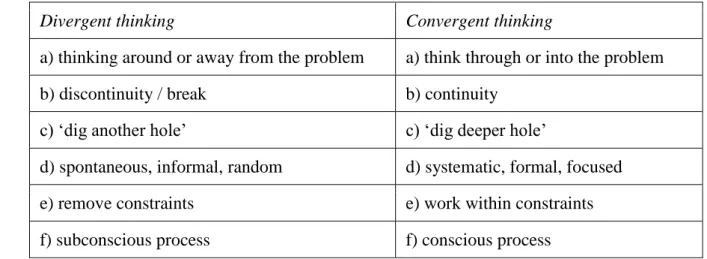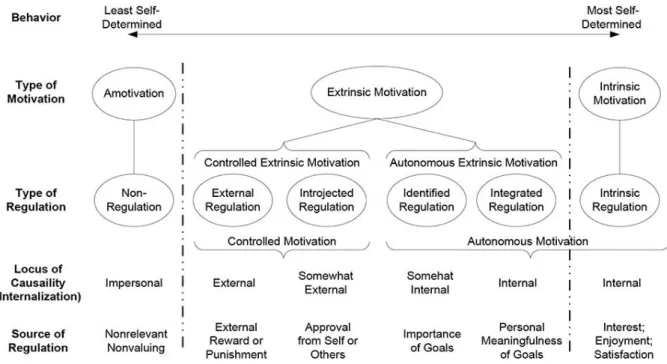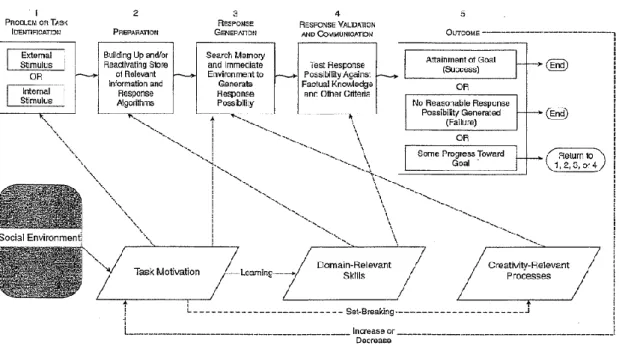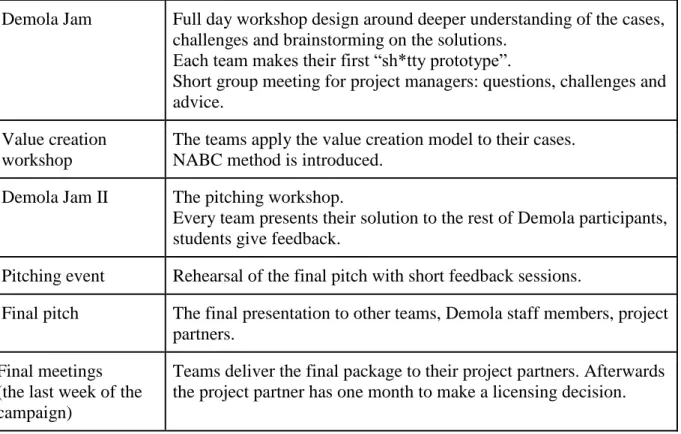Using the research strategy that combines two theories about innovation process and motivation, in particular, self-determination theory (Deci, & Ryan, 1985) and the componential theory of creativity (Amabile, 1997), I investigate the relationship between motivation, autonomy supporting or controlling management behavior and the work flow in the innovation media related projects. The quality of the motivation, or the combination of reasons for engaging in the activity, affects the production process as well as the final product (Deci, 2012).
Literature Review
Creativity, Innovation and Motivation
I also define a skill set that is essential for the innovation process and that describes the subjects of the study on a personal level. The factor of utility in the definition of creativity also stems from the psychological experiments where one's ability to solve problems was the measurement of the creative skills (Amabile, 1997).

Autonomy and Types of Motivation
According to the graph, the most self-determined behavior is intrinsic, which belongs to the strongest level of autonomous motivation and is based on the pleasure and satisfaction of engaging in the activity. In fact, all the motivations that characterize the different regulatory styles can be related to the reasons for participating in the activity.

Innovation as a Result of Teamwork
How the team members feel about the teamwork indicates how the creative process is going in the team. In the context of this thesis, it is important to highlight the flat hierarchy of the teamwork and a balance between the relationship between team members and tension of different mindsets, opinions and perspectives.

Methodology
- Philosophy and research Strategy
- Qualitative Research (The First Phase of Data Collection)
- Quantitative Research (The Second Phase of Data Collection)
- The Cases – Media Related Projects
- Qualitative Method (The Third Phase of Data Collection)
- Limitations
This phase of data collection took the form of semi-structured interviews with a predominance of open-ended questions. The interview was conducted by two Demola moderators, as they both participated in the formation of the teams for the Demola Tampere Autumn 2017 campaign. The interviews were conducted in September, at the very beginning of the Demola Autumn 2017 campaign.
The findings of the content analysis in the first phase lead to the decision to conduct a quantitative study. This part of the questionnaire is based on the existing Academic Self-Regulation Questionnaire (SRQ-A) (Ryan & Connell, 1999). In the case of the current paper, “the questions are about supporting respondents' autonomy”.
The quantitative surveys were based on the survey designed by the authors of the theory (see section Quantitative method, respondents and analysis).

The Context
- The Context: Smart City and Open Innovation
- History of Demola Tampere
- Concepts Applied in Demola Tampere
- Demola Tampere Framework
The platform's vision is to build the world's strongest innovation ecosystem by bringing together companies, universities and students and "combining the talent of the students with company R&D activities and university research" ("About - Demola Network", n.d.). Demola was also selected as “the best cross-border and cross-sector innovator in the Baltic Sea Region” and listed “as best practice for innovation policy makers worldwide” by the Organization for Economic Co-operation and Development (OECD) and the World Bank (Einarson et al., 2015, p. 756). The first meeting of the team members First meetings. the first week of the campaign).
At Demola Tampere, the role of the project partner is to provide resources (the information about the company needed for the project, materials or financial reimbursement), to be communicative (to be reachable, to give clear feedback and to participate in meetings) and to be open-minded (able to accept the ideas). Notably, it implies that the project partner is a team member because "the team is working with the project partner, not for the company" (facilitator #2), meaning that the students are not employees and are not doing the assignments for the company. The main role of the facilitator is to carry the responsibilities of a "facilitator". facilitator #4) by connecting the stakeholders, monitoring the work performance of the team, assisting the team where needed and making sure that each party – the team and the project partner – is keeping track of their responsibilities.
2011), “the best cross-border and cross-sector innovator” and “the best practice for innovation policy makers worldwide”.

Findings: Description and Analysis of Data
The Structure of the Innovation Process
For this reason, the description of the successful Demola Tampere project is very broad and the criteria refer both to the quality of the results (prototype/demo, solution of the problem, research on the subject, workability of a concept, licenses) and to the individual benefits (experience and employment). First, I draw my attention to the selection process, as it serves the purpose of the bottleneck and, according to Demola Tampere's facilitators, determines the future of the project. The logic of the selection process is based on the registrations of the participants and the intuition of the supervisors.
Again, this stage is critical to the innovation process, as the success of the selection process results in the quality of the workflow. It is also important to describe the role of the project managers within the framework of Demola Tampere. According to the facilitators, “[a project manager] is more like just a team member with a bit more responsibility” (facilitator #4) and not necessarily the leader of the team.
The listed criteria are used during the third research phase to examine the quality of the work flow in the innovation project (corresponding to the fourth research question).

Findings Related to the Research Questions
Comparing the results between the four teams (see Appendix 9) reveals that three cases (A, B and C) show the small percentage of controlled types of motivation (introverted and extrinsic regulatory styles). Consistent with the findings for teams' initial motivation, autonomous types of motivation remained dominant in cases A, B, and C. In case B, the project goal changed and team motivation decreased during the project.
This comparison allows me to see the consistency between team members' motivation and their perception of management. On the contrary, case D was distinguished by the dominance of the external motivational forces among team members. The team members' RAI ration strongly leans towards the controlling pole (-2.74 and -6) of the autonomy relative continuum.
This is consistent with the perception of management in the team as too controlling by one team member.
Discussion and Conclusion
Discussion of the Findings
The observed connection between the motivation of team members and their perception of management behavior can be explained in this way: the high level of external types of incentives (whose influence can be described with the idiom "carrots and sticks") results in the perception of the task as imposed from the outside and, consequently, management behavior as control that reduces participation in the interest of members in dilution (2) 017d, p. 149). It is important to mention that, as suggested in the literature, the perception of management behavior varies among team members and depends on their regulatory style, or set of motivational forces. Moreover, as the study shows (case D), the low presence of the identified type of motivation together with the dominance of external incentives reduces the level of internal interest in the project and results in the passive behavior of members, as well as in a hesitant work flow.
On the contrary, in the other team (case D) where the participants were extrinsically motivated and the task was perceived as algorithmic, the level of intrinsic motivation decreased by the end of the year. The results also show an increase in the complexity of regulatory styles in each case until the end of the project, which can be explained by the design of the research instruments that were applied to measure initial motivation and motivation during the project. This study also shows that the level of intrinsic motivation (case D) decreased significantly at the end of the project and the type of extrinsic motivation took the dominant position.
This corresponds to that of Mossholder (in Ryan & Deci, 2017d, p. 149), who experimentally proved that external motivation decreases the level of intrinsic interest in the task, and the.
Limitations and Further Research Recommendations
In particular, the strength of the identified type of motivation along with the extrinsic motivation remains dominant throughout the project, positively impacting team chemistry and workflow. It is important to emphasize that the findings of this study were interpreted with caution due to the limitations imposed by the time frame and constraints caused by the private policy of the Demola Tampere framework and the legal concerns of stakeholders. With that in mind, further research involving a larger sample of the innovation projects and covering a larger time frame is recommended.
Third, this article is also consistent with Self-Determination Theory (SDT), which is mainly represented by the works of Deci and Ryan and their collaboration with other researchers, especially the influence of autonomous and controlling types of motivation on the activity of team members, their perception of management and work flow. However, the findings of this paper illuminate challenging aspects of the theory, particularly the complexity of personal motivations and their dependence on social context and personal psychological fluctuations and individual changes in preferences. The type of leadership, the precise qualitative observation of the relationship between leadership and motivation of the participants, and the impact of this relationship on the innovation process and work flow are suggested for further studies.
In the context of the Demola Tampere platform, that was not possible due to the educational nature of the Demola Tampere platform, which implies a broad definition of a successful innovative project and the limitations imposed by the platform's private policy.
Implications for Media Managers
Another implication for project managers in short-term media-related innovation projects concerns the link between leadership and workflow. Positive: doubts the root of the problem, persistence (in the face of problems, lack of feedback from the project partner or lack of resources). Internal milestones: meeting with the project partner, visit to the project partner's premises, joint exit.
Yes No (if NO, go to Part Three) D. Why am I trying my part of the. This part of the questionnaire is for team members only and focuses on your experience with the project manager who is your most direct supervisor. What do you think were the main obstacles for YOU to give your best during the project.
Yes No (if NO, go to section four) D. Why do I try to do my part. Recent changes in the project have resulted in a greater workload for all team members. Point out that her team members will only stay on the project if they can remain productive at the current pace; and then watch their output carefully.



